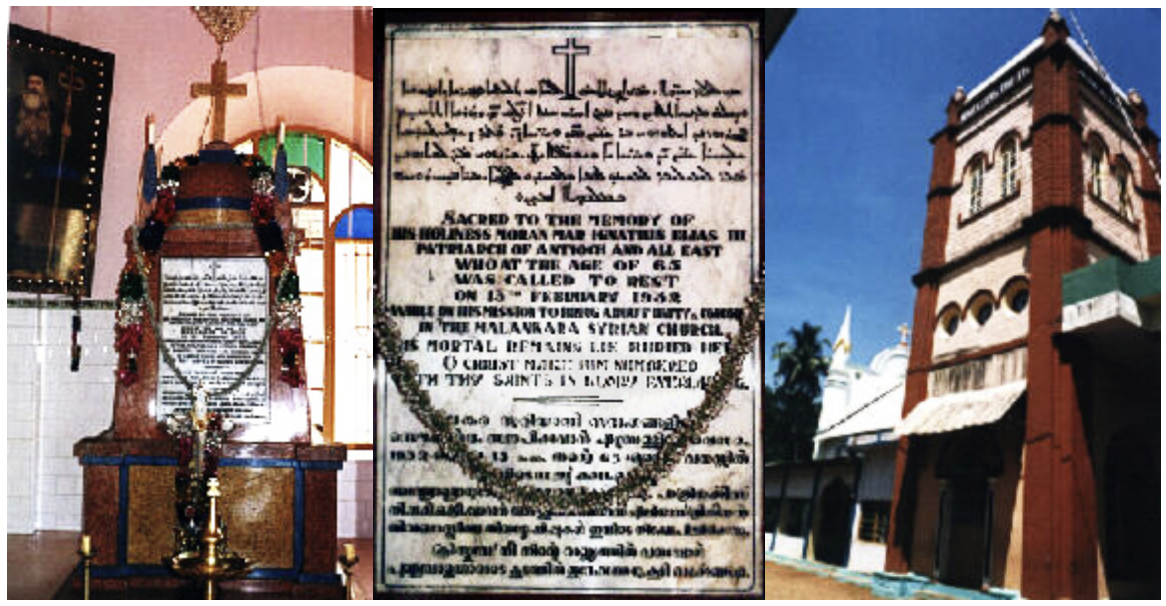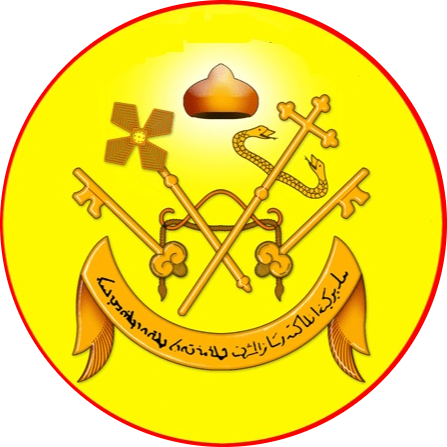St.Ignatius Elias III
Mor Ignatios Elias III was the 119th legitimate successor to St. Peter on the Holy Patriarchal See of Antioch.
- He was born Nasri; the second son Maryam and Archpriest Ibrahim Shaker, in Mardin, Turkey on 30th October 1867.
- He received his spiritual and ingenuous Christian faith and values at the hands of his righteous and virtuous parents.
- He received his elementary studies at the Forty Martyrs School in Mardin, Turkey.
- He was known of being a smart and a hard working student; and at the same time known of his obedience, all this was coupled with an excellent and superb manners.
- In the year, 1887 headed to Za’faran Monastery (Dayro f)”Korkmo” or Dayro Dmor Hanania) where he was ordained a deacon, and that was the time when he took the name ELIAS.
- At Za’faran Monastery, he exerted many efforts in his studies, thus he mastered both theology and literature.
- In the year 1889 became monk.
- In the year 1892, and at the hands of Patriarch of Antioch Mor Ignatius Boutros IV he became a priest, and was appointed at the Patriarchal See, thus becoming the Patriarch’s secretary at the time.
- He used to undertake his work with great enthusiasm and immense passion. In his free time, he used to study and read heavily, mainly the history of the Holy Church.
- Because of his zealousness to the holy church, he became trustworthy by all those who worked at the Patriarchate, he was appointed the patriarchal vicar in Diar Baker Parish (Amad).
- In the year 1895, Patriarch, Mor Ignatius Abdel Masseeh the second bestowed on him the honor of wearing the holy cross, and appointed him the Abbott of Mor Keryakous Monastery in Beth Shiroyeh where he served with great passion and enormous keenness.
- Through his zealousness and immense love to the holy church, rescued some seven thousand lives from being massacred at the hands of the enemies of the church, as he gave them refuge at the monastery.
In the year to follow, his services were moved to become the Abbott of Za’faran Monastery, the Head quarters of the Patriarchal See then. Once again he demonstrated great work ethic, where he assisted the immense number of orphans, and gave them refuge at the monastery,
In the year 1899, he was dispatched to the parish of Medyat (in Turkey) to calm down the unrest and all the unpleasant events that took place there amongst the church’s children.
Through his great wisdom, he was able to bring all the parties together for the benefit of the holy church, thus solving the problems amongst the children of the one holy church. He spent some three years at that place where all the parties honoured him, and he took the chance to take care of that parish’s school, thus improving this school’s standards.
- In the year 1902 his services were moved to the parish of Dyar Baker as the patriarchal vicar there, where his presence was highly visible through the upgrading of the faithful’s spiritual and educational levels.
- Being in that area he mastered the Turkish language, and took care of the parish churches. The faithful were very impressed with the standard of his services, thus voted him as their bishop. Therefore, he was promoted to the rank of bishop at the hands of Patriarch Mor Ignatius Abdallah the second in the year 1908 under the name of Mor Ivanius Elias.
- In the year 1911, he visited the parishes of Nuseibeen (i.e. Nisbis), Al-Jazeerah (in Syria), Tor Abdeen (in Turkey), as an Apostolic delegate. During these visits he ensured that the financial affairs of these parishes are organized, and inaugurated seven schools in the villages of these parishes.
- In the year 1912, his services were transferred to the parish of Mosul, Iraq.
- In the year 1914, he left to Mardin (in Turkey) as a member of the combined committee to draw up the “constitution”
- In the year 1915-1916, at the time when the violence erupted and the massacres were at their peak against our brethren in Turkey, he exerted every effort to take care of the migrants to Mosul in Iraq away from Turkey. He took care of everyone, no matter which church they used to be affiliated with, including the Armenians who migrated from Turkey.
- Following the departure of Patriarch Mor Ignatius Abdallah the second, and on 27th February 1916 he was elected as Patriarchal Overseer, thus left Mosul heading to Mardin on 17th October 1916.
- On 11th February 1917, and in a prestigious celebration he was enthroned on the Patriarchal See of Antioch, and from those who headed the celebrations of this great occasion was Archbishop Mor Ivanius Elias Halloleh.
- On 19th April 1919, and following the First World War, H.H. left Mardin, accompanied by a huge delegation heading to Constantinople. On his way H.H. visited the parishes in Syria to assure himself of the church’s children affairs. In Constantinople H.H. met Ottoman Sultan Wahid Eldeen, and was able to lobby him to issue a decree to safe keep the lives of the Christians in Mardin, Turkey and the region, and to restore the ownership of their properties.
- During that unstable and uncertain period of time, he requested the scholar H.E. Mor Severus Afram Barsoum, Archbishop of Syria and Lebanon then (H.H. Moran Mor Ignatius Afram Barsom I thereafter, 1957+), who was known to be fluent in French, to deputize him on behalf of the Holy Church at the Peace Conference that was held in Paris, France.
- On 8th July 1922 H.H. sailed from Constantinople to Jerusalem where he spent three months, during which he supervised the renovations of the monastery there.
- From Jerusalem he left to Damacus, then to Homs, then to Aleppo followed by Ankara where he met Mustafa Kamal the Turkish President then, and attended the inaugurating session of the National Council of Turkey.
- Between 11-25th October 1930 H.H. chaired the HolySynod that was held there, several Archbishops, bishops, priests and lay people participated. In this event he issued an apostolic bull that gave the faithful a summary of the recommendations of this Holy Synod to become aware of the affairs of the church.
- Thereafter, he decided to visit India, to bring forth peace amongst the children of the Holy Church. On 6th February 1931 he departed his Patriarchal See in Mosul farewelled by thousands of the church’s children from Mosul and St. Matthew Monastery’s parishes, who were overwhelmed with their feelings, thus their goodbyes were mixed with tears, seeking H.H. blessings, and praying for God the Almighty to make H.H. ‘s journey a safe one.
Source: St.Ephraim’s Syriac Orthodox Church, Perth. (2007). A Bright Light from the life of the very Glorious Patriarch The Thrice Blesses Saint Moran Mor Ignatius Elias III (1932-2007).
Patriarchal visit to Malankara (India)
On December 1, 1930, Lord Irwin, who was serving as the British Viceroy in India at that time, sent a letter to the Patriarch HH Ignatius Elias III. In the letter, he asked the Patriarch to personally intervene or send a delegate to help settle the dispute that had arisen within the Malankara Church of Kerala, India. Following this H.H. left Mosul on February 6, 1931, accompanied by Mor Clemis Yuhanon Abbachi, Rabban Quryaqos (later Mor Ostathios Quryaqos), and Rabban Yeshu` Samuel (later Mor Athanasius Samuel of North America), his secretary Zkaryo Shakir (his brother Joseph’s son) and translator Elias Ghaduri.
On February 28, 1931, they departed for India from Basra on a vessel named “Warsova.” They arrived at the Karachi port on March 5, 1931, where they were welcomed by Mor Yulius Elias Qoro, the Patriarchal Delegate, Mor Athanasius Paulos of Alwaye, and other clergy and followers.
On March 6, 1931, HH and his entourage proceeded to Delhi by train reaching there on the 8th and visited Lord Irwin. The Patriarch arrived in Madras on March 14th, 1931 and was hosted by Sir George Italy, the British Governor at the time.
After leaving Madras, the Patriarch arrived at the Thrikkunathu Seminary located in Alwaye on March 21st, and the following day, on March 22nd, 1931 he performed the divine liturgy there.
H.H. organized reconciliation meetings in Alwaye, Karingachira, Panampady, and Kuruppumpady. The Patriarch led the passion week services at Karingachira.
The denho (Epiphany) services in January 1932 were at the church in Pakkil.
On February 11, 1932, at the invitation of Qashisho Kuriakos Elavinamannil, the Patriarch arrived at the Manjinikkara Mor Stephanos church from Kallissery.
On February 12th, His Holiness recited many prayers of the qandilo (unction) and contemplated on the departed.
On February 13th, Mor Clemis Yuhanon Abbachi conducted the Holy Qurbono, with His Holiness delivering the sermon during the liturgy. Later, after noon prayers and lunch, the Patriarch recorded events in his journal, as was his habit. He requested a dictionary to clarify the meaning of a word before pacing around and complaining of a headache. Suddenly, he lost consciousness and was placed on a cot by the monks, where he slipped away into eternal rest at 2:30 pm. Witnesses describe the atmosphere in the area that evening as mournful, with monks accompanying the Patriarch wailing in grief.
It was decided that the final resting place of the Patriarch to be a piece of land located north of the Mor Stephanos Cathedral church, and the title of the land was transferred to the Patriarchate. The funeral of the Patriarch was conducted there on February 14th, 1932. Later, the Patriarchal delegate Mor Yulius Elias Qoro constructed the Mor Ignatios Dayro church over the tomb of the late Patriarch.

Tomb of Patriarch Elias III at Manjinikkara
Source: Syriac Orthodox Resources (2000)
The Holy Father’s life spanned over sixty four years and three months, of which he spent fourteen years, eleven months and eighteen days seated on the Holy See of Antioch. He consecrated the Holy Myron six times throughout his reign as Patriarch of Antioch and ordained ten bishops.
During the reign of H.H. Moran Mor Ignatius Elias Ill, an enormous number of churches were built in different parts of the world. H.H. played a major role in encouraging the generous faithful to expand on their ideas and construct churches.
The memory of the Holy Father is revered throughout the Syriac Orthodox Church and especially in Malankara where thousands of pilgrims reach the tomb by foot on the annual feast day, February 13, from various parts of the Kerala state. On October 20, 1987, Patriarch Mor Zakka I through encyclical E265/87 permitted the Church in Malankara to remember his name in the fifth diptych.

